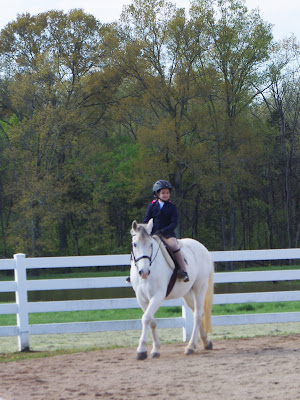I have a list in my head of the assorted skills that I would like Donut to develop during her first few years with me. Being clipped is definitely near the top of that list. Over the past few months, I've done maybe three short sessions with Donut, getting her used to the sight and sound of my quiet, battery-operated clippers. I haven't done any actual clipping, though, because she was giving them the eye that tells me she is tolerating them, but not happy about them.
A few days ago, I decided to work on clipping a bit more diligently. Spring is nearly over here, and we should have temperatures in the mid- to high-80s for several days this week. We could still have a few cooler nights, but I don't expect we will get any more near-freezing temperatures, and the 90s aren't far away. That means I can actually start taking some hair off without risking Donut getting chilled or needing a blanket.
I started my session as I typically do, with Donut in her stall, munching on some alfalfa hay. I went through the slow process of checking to see how she felt about the clippers. I stood several feet away from her to start and just turned them on. As soon as she looked at them, I turned them off. I repeated that process a few times. Then I started to move closer about every 10 seconds. If I noticed tension in her body, I stayed where I was until she looked at the clippers and then turned them off for a bit.
After a few minutes, I was able to run the clippers over her hindquarters, using the back of the blade, so I wasn't clipping any hair. Once she seemed comfortable with that, I started actually taking some hair off, as if I would be starting a trace clip. She did really well with that, so after I clipped a small area, I called it a day.
 |
| Day 1 progress. It's not pretty, but that's OK! |
Well, I admit to being pretty impressed with myself and Donut after that first session, so I got it in my head that I could just work on a new section of her body every day and have a full trace clip after a week. What is the saying? Something about nothing teaching humility faster than a horse?
I went into my second session the next day expecting to briefly go over what I'd done the day before and start clipping either the other side of Donut's haunches or her belly. Donut quietly explained to me that that wasn't going to happen. I'm not sure if she could sense my intent or if I just went through the previous day's process too fast for her, but she walked away from her food and me as soon as she felt the blades on her coat, which told me that she was not ready for more.
So I regrouped, and spent some more time with her just trying to get back to where we'd been the day before. As soon as I got that, I stopped for the day, and reminded myself that not every horse is the same and they all learn and adapt to new things in their own time.
For Day 3 of the clipping extravaganza, I went in to it with a much better mind-set. My plan was simply to see if I could repeat what I'd done the first day and that maybe instead of planning to take a day with each part of her body, I should plan for a week. After all, there is no rush. There is no show or competition. And she is steadily shedding, so the long hair won't be there much longer anyway.
I was able to repeat what I did on the first day, and then I decided to try clipping just a little more to see how Donut handled that. She did great, and I expanded the clip a little on her hind leg. I was also able to start running the clippers over her back and belly, using the back of the blade.
 |
| Progress on Day 3. It is starting to look like a legitimate clipping job! |
The thing that I learned from the past few days is that I still need a reminder every once in awhile about taking the time it takes to move through a process, and that I can't assume anything about future progress based on the current progress. Stay tuned to see how long it takes me to get Donut clipped! :)





